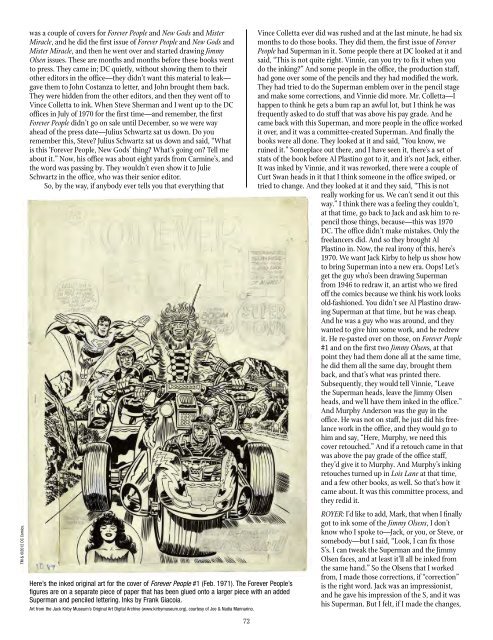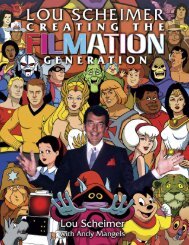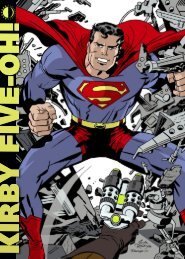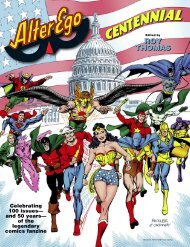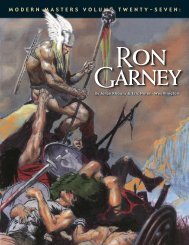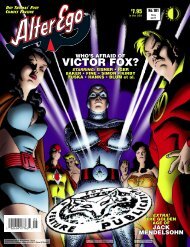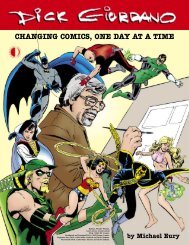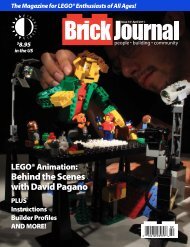Preview - TwoMorrows
Preview - TwoMorrows
Preview - TwoMorrows
You also want an ePaper? Increase the reach of your titles
YUMPU automatically turns print PDFs into web optimized ePapers that Google loves.
TM & ©2012 DC Comics.<br />
was a couple of covers for Forever People and New Gods and Mister<br />
Miracle, and he did the first issue of Forever People and New Gods and<br />
Mister Miracle, and then he went over and started drawing Jimmy<br />
Olsen issues. These are months and months before these books went<br />
to press. They came in; DC quietly, without showing them to their<br />
other editors in the office—they didn’t want this material to leak—<br />
gave them to John Costanza to letter, and John brought them back.<br />
They were hidden from the other editors, and then they went off to<br />
Vince Colletta to ink. When Steve Sherman and I went up to the DC<br />
offices in July of 1970 for the first time—and remember, the first<br />
Forever People didn’t go on sale until December, so we were way<br />
ahead of the press date—Julius Schwartz sat us down. Do you<br />
remember this, Steve? Julius Schwartz sat us down and said, “What<br />
is this ‘Forever People, New Gods’ thing? What’s going on? Tell me<br />
about it.” Now, his office was about eight yards from Carmine’s, and<br />
the word was passing by. They wouldn’t even show it to Julie<br />
Schwartz in the office, who was their senior editor.<br />
So, by the way, if anybody ever tells you that everything that<br />
Here’s the inked original art for the cover of Forever People #1 (Feb. 1971). The Forever People’s<br />
figures are on a separate piece of paper that has been glued onto a larger piece with an added<br />
Superman and penciled lettering. Inks by Frank Giacoia.<br />
Art from the Jack Kirby Museum’s Original Art Digital Archive (www.kirbymuseum.org), courtesy of Joe & Nadia Mannarino.<br />
72<br />
Vince Colletta ever did was rushed and at the last minute, he had six<br />
months to do those books. They did them, the first issue of Forever<br />
People had Superman in it. Some people there at DC looked at it and<br />
said, “This is not quite right. Vinnie, can you try to fix it when you<br />
do the inking?” And some people in the office, the production staff,<br />
had gone over some of the pencils and they had modified the work.<br />
They had tried to do the Superman emblem over in the pencil stage<br />
and make some corrections, and Vinnie did more. Mr. Colletta—I<br />
happen to think he gets a bum rap an awful lot, but I think he was<br />
frequently asked to do stuff that was above his pay grade. And he<br />
came back with this Superman, and more people in the office worked<br />
it over, and it was a committee-created Superman. And finally the<br />
books were all done. They looked at it and said, “You know, we<br />
ruined it.” Someplace out there, and I have seen it, there’s a set of<br />
stats of the book before Al Plastino got to it, and it’s not Jack, either.<br />
It was inked by Vinnie, and it was reworked, there were a couple of<br />
Curt Swan heads in it that I think someone in the office swiped, or<br />
tried to change. And they looked at it and they said, “This is not<br />
really working for us. We can’t send it out this<br />
way.” I think there was a feeling they couldn’t,<br />
at that time, go back to Jack and ask him to repencil<br />
those things, because—this was 1970<br />
DC. The office didn’t make mistakes. Only the<br />
freelancers did. And so they brought Al<br />
Plastino in. Now, the real irony of this, here’s<br />
1970. We want Jack Kirby to help us show how<br />
to bring Superman into a new era. Oops! Let’s<br />
get the guy who’s been drawing Superman<br />
from 1946 to redraw it, an artist who we fired<br />
off the comics because we think his work looks<br />
old-fashioned. You didn’t see Al Plastino drawing<br />
Superman at that time, but he was cheap.<br />
And he was a guy who was around, and they<br />
wanted to give him some work, and he redrew<br />
it. He re-pasted over on those, on Forever People<br />
#1 and on the first two Jimmy Olsens, at that<br />
point they had them done all at the same time,<br />
he did them all the same day, brought them<br />
back, and that’s what was printed there.<br />
Subsequently, they would tell Vinnie, “Leave<br />
the Superman heads, leave the Jimmy Olsen<br />
heads, and we’ll have them inked in the office.”<br />
And Murphy Anderson was the guy in the<br />
office. He was not on staff, he just did his freelance<br />
work in the office, and they would go to<br />
him and say, “Here, Murphy, we need this<br />
cover retouched.” And if a retouch came in that<br />
was above the pay grade of the office staff,<br />
they’d give it to Murphy. And Murphy’s inking<br />
retouches turned up in Lois Lane at that time,<br />
and a few other books, as well. So that’s how it<br />
came about. It was this committee process, and<br />
they redid it.<br />
ROYER: I’d like to add, Mark, that when I finally<br />
got to ink some of the Jimmy Olsens, I don’t<br />
know who I spoke to—Jack, or you, or Steve, or<br />
somebody—but I said, “Look, I can fix those<br />
S’s. I can tweak the Superman and the Jimmy<br />
Olsen faces, and at least it’ll all be inked from<br />
the same hand.” So the Olsens that I worked<br />
from, I made those corrections, if “correction”<br />
is the right word. Jack was an impressionist,<br />
and he gave his impression of the S, and it was<br />
his Superman. But I felt, if I made the changes,


